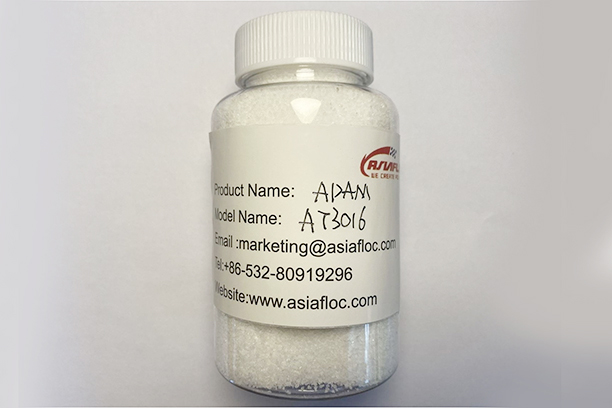Production process of polyacrylamide
Production process of polyacrylamide

1 Process flow
The industrial development of 2 x 104t/a polyacrylamide includes two main process units, AM and PAM. AM plant process mainly includes AN raw material preparation, air purification, biological fermentation, catalytic reaction and AM refining five processes; PAM device mainly includes AM liquid distribution, AM polymerization, PAM granulation, PAM drying, grinding, screening, packaging and other processes.
A, AN raw material preparation
The purpose of this process is to remove the polymerization inhibitor (hydroquinone monomethyl ether) added during the storage and transportation of raw material AN.
After heating, AN from the storage tank goes into the flash tank and flashes in the vacuum state. The gas phase goes into AN intermediate storage tank after condensation and cooling.
B. Air purification
The purpose of this process is to produce oil-free, sterile air for bacterial culture.
The compressed air (0.35mpa) is cooled to separate part of the water and control the dewpoint of the air below 20℃. After reheating, it is fed into the main filter to eliminate the mixed bacteria in the air and send to the fermentation process.
C. Biological fermentation
The purpose of this process is to produce bacteria containing nitrile hydrase.
The first step of operation is to feed the culture medium into the seed tank, propagation tank and fermentation tank; The second step is to use steam to strictly disinfect the equipment and culture liquid; The third step is to transplant, reproduce and ferment to produce fermentation liquid with high enzyme activity.
This procedure is intermittent operation.
D, catalytic reaction
The purpose of this process is to complete the conversion of AN and H2O into AM under the action of biological enzyme catalyst.
Fermented by immobilized cell technology to produce granular enzyme catalyst, and water in a certain proportion into the catalytic reactor, refined after AN after measuring the drop to catalytic reactor, control the solution in the reactor in the AN concentration in the 3-4%, at the same time control the temperature of the reactor, AM achieving concentration, the AN when the concentration of 500 mg/l or less into AM tundish.
The effective activity of the biological enzyme catalyst is three cycles. After three cycles, the catalyst is filtered and separated and sent to incineration.
E, AM refined
The purpose of this process is to separate the light component impurities brought into AM by raw materials, as well as impurities brought into media, catalyst and equipment, including biological cells, organic matter, metal ions, etc.
AM aqueous solution is flash distilled under high vacuum to remove the light components brought by AN raw material, and then filtered into ultrafiltration membrane filter to remove biological cells and organic matter, and then demetallized by ion exchange resin to obtain AM aqueous solution products that meet the requirements of subsequent polymerization process.
F, AM solution
The purpose of this process is to prepare AM, H2O and alkali in a certain proportion into a predetermined concentration of mixed solution, while controlling the temperature of the solution in the set range.
G, polymerization, hydrolysis
The purpose of this process is to polymerize AM into high molecular weight PAM colloid under the action of initiator, and perform hydrolysis reaction in the same polymerization kettle to achieve the required degree of hydrolysis.
AM solution into the polymerization kettle, pure N2(99.99%) to remove THE O2 in the solution, and then according to the predetermined procedure and amount of various initiator, polymerization reaction, the reaction process does not need temperature control. After the completion of the polymerization reaction, hot water is fed into the jacket of the polymerization kettle to hold the hydrolysis reaction.
H. PAM colloid granulation
The purpose of this process is to cut PAM glue block into 3-6mm colloidal particles.
PAM colloid from the polymerization kettle with air pressure into the storage box, and then from the storage box into the granulator. The screw in the granulator conveys the colloid from the feeding port to the knife hole, and the pressure of the screw makes the colloid extruding from the knife hole to form a thin strip, and then the rotary cutting TJ knife with the knife hole will cut the rubber strip into particles.
Through the granulator can get the particle size of about 3-6mm colloidal particles, and then by pneumatic conveying the colloidal particles into the dryer.
I, PAM drying
The purpose of this process is to change PAM colloid into solid granular PAM with water content decreasing from 75% of the colloid to 10% of the solid PAM.
The dryer is divided into two stages. The first stage is dried with 110-120℃ hot air until PAM contains about 25% water. The second stage is dried with 90-70℃ hot air until PAM contains 10% water, and then cooled to 55℃. Drying is divided into two production lines, one line size 6500t/a, using domestic developed products; The other line size 13500t/a, using imported equipment.
The NH3 and H2O vapor produced in the drying process is discharged into the air together with the air.
J, grinding and packaging
The purpose of this process is to grind the solid large granular PAM into small granular powder, divide the granular PAM dry powder of 0.15-1.omm by screening, and package it into bags.
The products from the vibrating screen are transported to the cyclone separator by negative pressure pneumatic, and the material at the bottom of the cyclone separator is divided into three parts by the double-layer sieve separator, and the fine powder is fed into the bag by the hopper; Coarse particles into the grinding machine for regrinding, and then sent to the cyclone separator; The particles that meet the requirements are transported to the mixing hopper, so that the products of different reaction kettle are mixed to get uniform products, and then measured and bagged by the packaging machine.


